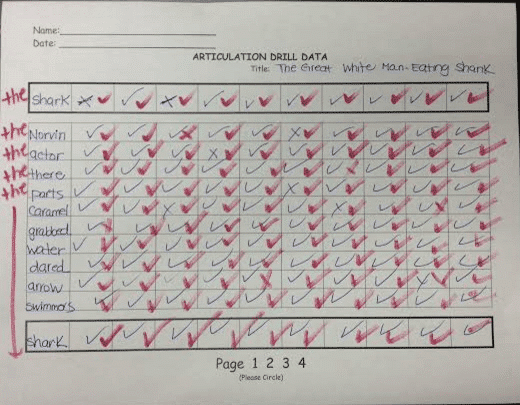In our last post, we talked how making your SLP-efforts cumulative helps you be a more effective, efficient, and happier SLP. Today, we are going to talk about how one articulation method can:
1. Get students to generalize their sounds and graduate from speech therapy quicker.
2. Decrease your caseload and earn you more time to tackle your other SLP responsibilities.
Are you seeing your speech students in a group setting while doing turn-taking games? If so, you are likely to get about 20 repetitions of the target sound. The research out there says that doing 5-7 minutes of drill, drill, drill daily can, on average, graduate a child from speech therapy after 7 hours of intervention (Sexton, 2006; Kuhn, 2006). Traditional therapy, however, resulted in 63 hours of speech therapy. That’s a difference of 9 months versus 18 months of speech therapy. Essentially, distributing your speech efforts in small, frequent bursts over time is better than a “mass-attack” of articulation therapy (Willingham, 2002). Remember, this is the research. Let me tell you how this can happen (in real life) on your campus and in your clinic.
First, we acknowledge that it would be ideal to see students every day for a few minutes; however, this may not be feasible. We get it. You are on a campus one or two days a week, or you see your clients in the office or in the home one time a week. Let’s talk about how we can still use drill, drill, drill within the setting you currently have set up. I have been using this method for over 10 years in the schools and in the clinic, and it works. What if your child could leave a speech session with 300+ repetitions of a sound/word/phrase/sentence?! Let’s get schooled in drill therapy!
Step one: Find a method for counting. You need to find a way for your children to tally their productions. I like to use a counter. It’s my magical tool. You can find them on Amazon for about $4. After showing the student how to use the tool, he tracks his own productions. Remember, children who are able to gauge their own productions are ready for this type of therapy. In other words, if your student is not able to determine when he makes a sound error, he’s not yet ready for this. It’s amazing how excited students are to see the number of their productions increase. Just yesterday, I had a 5-year-old say to his mom, “I made my sound 225 times!”
If you don’t have a counter, you can also use a sheet of paper with 110 boxes drawn on it. To make it easy for you, here is the Articulation Drill Sheet Template*. Notice, there is a list of 11 target words written on the left side. Next to each target word are 10 boxes for students to place a “check” for correct productions and an “x” for atypical productions. I typically use the top row when I am sitting with the child—this is an opportunity for me to give feedback. After the first row, students work independently. Here is a sample of /r/ words from the book The Great White Man-Eating Shark I used with one of my clients. Quick tip–use books to find your words:

1. Kara produces and tallies beginning /s/ words in blue ink for 100 words. This takes 5 minutes.
2. Kara touches base with me. “Kara, now using your red pen, do the same words and add the word “the” before your /s/ words. Look, now you are saying your /s/ words at the phrase level!” This takes 1 minute.
3. Kara goes back to her desk and says her next 100 target word at the phrase level and tallies this with a red pen on the same sheet of paper. This takes 5 minutes.
Within a 30-minute session, Kara says her targeted sound 500+ times! Here is a video of Kara working on her /s/ sound:
Step two: Find a way for drill, drill, drill to take place every single day. If you are in the schools, find 5 minutes to talk to the student’s teacher. Since your student is already able to self-assess his own correct productions, he can do this in the classroom. Meet with the teacher for 5 minutes and deliberately schedule a time when your student can do this daily in the classroom. Maybe it’s at the beginning of the day when students are arriving to class. Maybe it’s during Language Arts, and your student can say words that are a part of the story the teacher has read that week. I even had one student do this with a classroom peer during the daily “silent reading” time in the hallway.
You can also talk to parents about doing this at home. How? I have sent home the exact drill sheet that we work on in speech and ask students and parents to do the exact same thing on a daily basis. Remember, the video of Kara? I have texted short video snippets to parents to let them see what the drill, drill, drill “looks like” and “sounds like.” This makes it easier for parents to know what to do at home.
There you have it! Stay tuned for our next installment of this series: Step 3 Save Time and Money with Great Speech Therapy Materials.
*In the spring of 2005, my life as a speech-language pathologist changed. Tammy Qualls, my lead at the time, sat down and showed me this method of articulation therapy. I give her full credit for this document. We are lucky in our profession to work alongside some awesome and giving individuals.





I love it! In the past I’ve tried to do five minutes a day every day for my students but spent too much time running around the school and ended up not being able to get to everyone. This is very doable!
Troy, thanks for your feedback. I know it can be challenging to find a schedule that meets everyone’s needs and maximizes your time. This strategy is definitely doable. Let us know how it goes. We love to hear feedback. Here’s to effective (and fun!) therapy. Take care, Phuong.
Thank you for the reminder, tips and tools, and modeling of how this can be done EVERY DAY.
Mariah, thanks so much for your feedback. Let us know how this goes. I whole-heartedly believe in this strategy, and the results are impactful! Take care, Phuong.